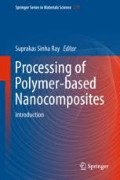Abstract
Processing conditions (e.g., temperature profile, feed point, screw speed, feed rate , and screw element configuration) and how nanocomposites are prepared in the extruder have a vital effect on the dispersion of nanoclay . The resultant morphology of nanocomposites is not only a question of shear stress or residence time , but also a result of the entire mechanical and thermal history of the material when extruded. Hence, this study intends to extensively investigate the aspects of processing conditions, such as temperature profile, feed point, screw speed, feed rate , and screw element configuration, and the relationship between the different parameters (optimal conditions). The clay-containing polymer nanocomposite has been selected as a model system and the effects of nanoclay and maleic anhydride grafted PP loading on the dispersion of nanoclay in the PP nanocomposite have been investigated. The aim of this study is to investigate ways of improving the dispersion of nanoclay in the PP matrix and to determine how the state of dispersion affects the morphology and properties of resultant PP nanocomposites . A co-rotating twin-screw extruder was used to produce nanocomposites owing to the flexibility of the screw profile, screw speed, feed rate , and material feeding in different areas of the machine.
Access this chapter
Tax calculation will be finalised at checkout
Purchases are for personal use only
References
Technical Brief: Particle Science, 3. 2011. http://www.particlesciences.com/docs/technical_briefs/TB_2011_3.pdf.
Bandyopadhyay J, Ray SS, Scriba M, Wesley-Smith J. A combined experimental and theoretical approach to establish the relationship between shear force and clay platelet delamination in melt-processed polypropylene nanocomposites. Polymer. 2014;55:2233–45.
Borse NK, Kamal MR. Estimation of stresses required for exfoliation of clay particles in polymer nanocomposites. Polym Eng Sci. 2009;49:641–50.
Fornes TD, Paul DR. Structure and properties of nanocomposites based on nylon-11 and -12 compared with those based on nylon-6. Macromolecules. 2004;37:7698–709.
Yuan Q, Misra RDK. Impact fracture behaviour of clay-reinforced polypropylene nanocomposites. Polymer. 2006;47:4421–33.
Li J, Ton-That MT, Leelapornpisit W, Utracki LA. Melt compounding of polypropylene-based clay nanocomposites. Polym Eng Sci. 2007;47:1447–58.
Lertwimolnum W, Vergnes B. Influence of screw profile and extrusion conditions on the microstructure of polypropylene/organoclay nanocomposites. Polym Eng Sci. 2007;47:2100–9.
Nalini R, Nagarajan S, Reddy BSR. Polypropylene-blended organoclay nanocomposites—preparation, characterisation and properties. J Exper Nanosci. 2013;8:480–92.
Dong Y, Bhattacharyya D. Experimental characterisation and object-oriented finite element modelling of polypropylene/organoclay nanocomposites. Compos A. 2008;39:1177–91.
Santos SK, Demori R, Mauler SR. The influence of screw configurations and feed mode on the dispersion of organoclay on PP. Polimeros. 2013;23:175–81.
Hasegawa N, Kawasumi M, Kato M, Usuki A, Akane O. Preparation and mechanical properties of polypropylene-clay hybrids using a maleic anhydride-modified polypropylene oligomer. J Appl Polym Sci. 1998;67:87–92.
Ray SS. Clay-containing polymer nanocomposites: from fundamentals to real applications. 1st ed. Oxford: Elsevier; 2013.
Ojijo V, Ray SS, Saduku R. Effect of nanoclay loading on the thermal and mechanical properties of biodegradable polyactide/poly[(butylene succinate)-co-adipate] blend composites. ACS Appl Mater Interfaces. 2004;4:2395–405.
Poulesquen A, Vergnes B. A study of residence time distribution in co-rotating twin-screw extruders. Part I: theoretical modelling. Polym Eng Sci. 2003;43:1841–8.
Bigio DI, Elkouss P, Wetzel MD, Raghavan SR. Influence of polymer viscosity on the residence distributions of extruders. Aiche. 2006;52:1451–9.
Fel E, Massardier V, Melis F, Vergnes B, Cassagnau P. Residence time distribution in a high shear twin screw extruder. Int Polym Proc. 2014;29:71–80.
Domenech T, Peuvrel-Disdier E, Vergnes B. Influence of twin-screw processing conditions on structure and properties of polypropylene-organoclay nanocomposites. World Congr Polym Proc Soc. 2012;27:517–26.
Bandyopadhyay J, Malwela T, Ray SS. Study of the change in dispersion and orientation of clay platelets in a polymer nanocomposite during tensile test by variostage small-angle X-ray scattering. Polymer. 2012;53:1747–59.
Acknowledgements
The authors would like to thank the Department of Science and Technology and the Council for Scientific and Industrial Research, South Africa, for financial support.
Author information
Authors and Affiliations
Corresponding author
Editor information
Editors and Affiliations
Rights and permissions
Copyright information
© 2018 Springer Nature Switzerland AG
About this chapter
Cite this chapter
Morajane, D., Sinha Ray, S., Bandyopadhyay, J., Ojijo, V. (2018). Impact of Melt-Processing Strategy on Structural and Mechanical Properties: Clay-Containing Polypropylene Nanocomposites. In: Sinha Ray, S. (eds) Processing of Polymer-based Nanocomposites. Springer Series in Materials Science, vol 277. Springer, Cham. https://doi.org/10.1007/978-3-319-97779-9_5
Download citation
DOI: https://doi.org/10.1007/978-3-319-97779-9_5
Published:
Publisher Name: Springer, Cham
Print ISBN: 978-3-319-97778-2
Online ISBN: 978-3-319-97779-9
eBook Packages: Physics and AstronomyPhysics and Astronomy (R0)

